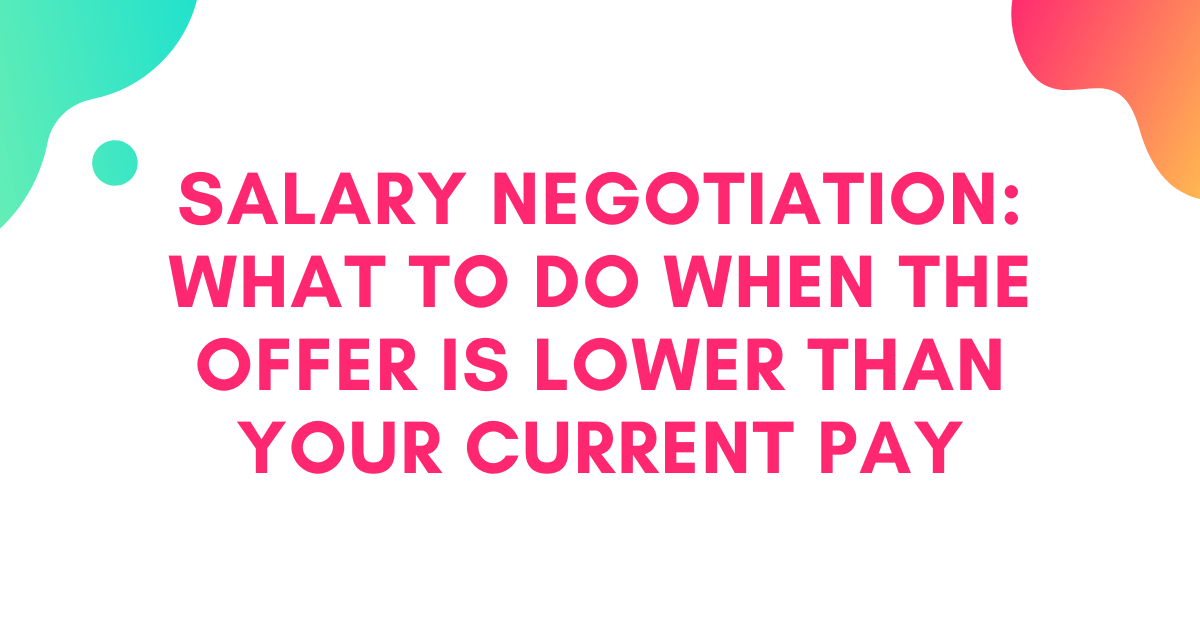Salary Negotiation: What to Do When the Offer Is Lower Than Your Current Pay
You might be wondering, why bother pursuing a job that pays less?
For my client, an engineering manager, the answer was simple: there were far more compelling aspects of the new opportunity. The ability to work fully remote, the chance to work on an exciting product, and the prospect of reporting to a manager who felt much more relaxed and relatable compared to the stiff and rigid leadership she was currently dealing with.
And, of course, she knew that offers are negotiable.
Armed with confidence-boosting tools, my client aced the technical and behavioral interviews. When it became clear an offer was on the table, she reached out to me: "How should I negotiate this?"
Here's how we approached it with three key steps:
1. Break the Low Anchor with a Higher One
The first step in salary negotiation is understanding the concept of "anchoring." Anchoring is the cognitive bias where people lean towards the first number introduced in a negotiation, especially when things are uncertain.
In this case, the employer had set an anchor with a base salary that was $30K lower than my client's current pay. The quoted base pay was at the bottom end of the pay range for the role: $160K in a pay range $160K - $190K.
To counter this, I coached her to set a higher anchor—without making it about her current salary, but on the merit of her experience and skill.
Beginning anchor set by the potential employer: $160K base pay + up to 30% bonus + equity + fully remote work
We carefully reviewed her current compensation package, considering her base salary, bonus, equity, health benefits, and perks. Then we compared it to the total compensation from the new offer.
Client’s current all-in compensation: $190K base pay + up to 10% bonus + equity + hybrid work
Despite the lower base salary, the 30% bonus structure, higher stock valuation, and remote work savings meant that her total earnings would exceed her current package.
New potential all-in compensation > Current all-in compensation
This insight allowed her to feel comfortable “breaking” the low anchor. The lower base pay no longer felt like a dealbreaker; it was just the cherry on top of a larger offer.
This shift in perspective meant less pressure during the conversation, and greater ease led to more confidence.
2. Bring Curiosity to the Back-and-Forth
Although my client felt more at ease, she was still unsure about how to frame her request for a higher base salary.
I reminded her of the research in negotiation psychology, which shows that moderate back-and-forth—offers and counteroffers—tends to lead to better satisfaction among negotiators, compared to either very quick or very drawn-out discussions.
Given that the pay range for the role was between $160K - and $190K, we strategized that asking for $195K base pay would be a strong counter-anchor—ambitious yet within reason based on her experience and going market rate.
By setting this higher anchor, she positioned her at the top of the stated range while also leaving room for negotiation.
We fully anticipated that the employer may counter with $190K base (which is exactly what they did).
In case of pushback, I encouraged her to approach the negotiation with curiosity, rather than faking bravado. She was concerned that being too confident might come across as arrogant (a fear many of my female clients share, though it’s rarely a concern for men).
I reassured her that asking open-ended questions wouldn't make her seem overly assertive or dismissive. In fact, it could invite more transparency, such as:
“Could you share how you arrived at this initial offer?”
“When do you typically make salary adjustments for employees?”
This type of curiosity helps keep the conversation productive and focused on finding a mutually beneficial solution.
3. Imagine It Done and Dusted
My client brought a strong level of confidence to the interviews, so I encouraged her to carry that same confidence into the salary negotiation.
I often draw inspiration from my own routine with my virtual fitness coach (Kim Ngo on Apple Fitness+ in case you’re curious).
After each workout, she always says, “Great job! The workout is done and dusted.” This phrase helps me mentally close the loop, knowing the workout is finished. It creates a sense of satisfaction, and my mind anticipates the gratification before I even start.
I applied the same concept to my client’s situation. I had her imagine the salary negotiation as already done—successful, smooth, and complete. I asked her to visualize herself merging with the future version of herself: the one who had successfully negotiated, secured the offer, and was already thriving in her new role.
This mental shift helped her walk into the negotiation with confidence, feeling as if she had already won.
TLDR;
Here’s the logic of this negotiation, step by step:
Current Compensation
Base salary: $190K
Bonus: Up to 10% = $19K
Total cash comp excluding equity, benefits, and perks: $209K
New Job Offer (Initial):
Base salary: $160K
Bonus: Up to 30% = $48K
Signing bonus: $10K
Total cash comp excluding equity, benefits, and perks: $218K
But with added benefits of fully remote work (about additional $10K) and better equity upside (another $10K), the total all-in compensation would exceed her current compensation.
Negotiated Offer (Final):
Base salary: $190K
Bonus: Up to 30% = $57K
Signing bonus: $10K
Total cash comp excluding equity, benefits, and perks: $227K
With the additional benefits of full remote work and stronger equity potential, my client walked away with not only a higher total compensation package but also a better quality of life, more exciting work, and a supportive manager—proving that negotiating isn’t just about money; it’s about aligning your career with your values and priorities.




